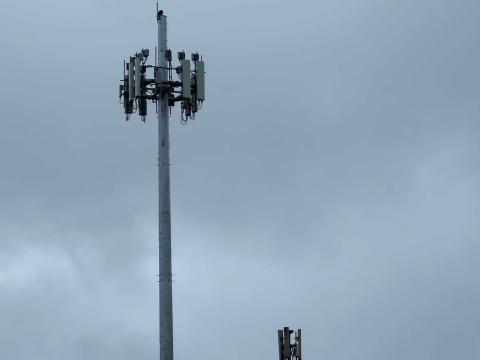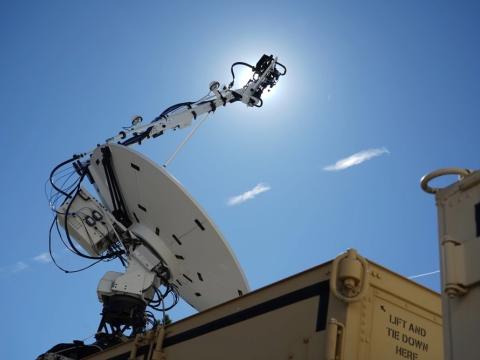Keeping Track Of the Blue Force
System answers questions: Where am I? Where are my buddies? Where is the enemy?
Sophisticated tracking and communications capabilities rapidly installed on military platforms in the Middle East helped U.S. and coalition commanders in Afghanistan and Iraq slice through the fog of war with near-real-time situational awareness. Blue force tracking technology provides information about the location of friendly and enemy forces as well as terrain and danger zones such as mine fields. Equipment installed on a variety of platforms continues to allow mission leaders, commanders and warfighters in locations from the Pentagon to the battlefield to see the same picture of and elements in the battlespace like pieces on a chessboard.
While operations in Afghanistan were well underway and war in Iraq was looming, the U.S. Army set to work installing Blue Force Tracking systems in high-mobility multipurpose wheeled vehicles (HMMWVs), command and control platforms, operations centers and shelters. Fielding support from the Tobyhanna Army Depot, urgent contracts awarded by the Communications-Electronics Command (CECOM) and around-the-clock efforts from industry helped place more than 1,000 systems on platforms at 43 locations on three continents. Northrop Grumman Mission Systems, Reston, Virginia, developed the software, and DRS Technologies Incorporated, Palm Bay, Florida, manufactured the hardware. Tobyhanna’s Production Engineering Directorate designed the kits on an accelerated schedule, and the depot’s Systems Integration and Production Support directorates built the kits, which provide the electrical and mechanical interfaces for the equipment.
Derived from the Force XXI Battle Command Brigade and Below (FBCB2) program, Blue Force Tracking systems provide unprecedented vertical and horizontal information integration, users in the field say. The network, which allows warfighters to send and receive information across the depth and breadth of the battlefield, features a large mission database. The mission data loader is used to insert maps, overlays and databases into individual units on platforms.
Positioning information gathered from the global positioning system (GPS) and data provided by users are sent through an L-band satellite to data fusion centers at command centers. Aggregated information is then relayed back through satellites to all commanders on the network where it is viewed on a common map. These maps, which are generated from the National Imagery and Mapping Agency, and satellite imagery are geo-referenced, so users also see the locations of rivers and other land features.
Research into technological advances to improve situational awareness in the battlespace began in earnest immediately after the first Gulf War. During that conflict, troops had difficulty finding their way around featureless landscapes that “resemble the moon,” explains Thomas Plavcan, deputy project manager, FBCB2, Fort Monmouth, New Jersey. By the mid-1990s, the first “blue icon” appeared on the tactical Internet, and later that decade, software and satellites enabled commanders of troops involved in operations in the Balkans to know precisely the locations of their people, vehicles and other platforms. These first digitization initiative systems evolved into Blue Force Tracking capability, which today features the capability to communicate via radio, free-text messaging and e-mail. To date, it has been installed on Army, U.S. Marine Corps and U.K. military platforms.
The technology supports several aspects of a mission. Using the most current situational awareness information, commanders plan operations and communicate intent and mission plans to troops. In addition, they can coordinate air and ground forces to attack designated targets. Blue force tracking enhances navigation in limited visibility situations by allowing air and ground vehicles to travel through fog, dust and sandstorms or at night. Reconnaissance teams can send information about enemy locations using preformatted text messages or by communicating through the chat capability.
Security within the transceiver adequately protects the information, Plavcan relates, but it is not at the secret level. However, as the data are aggregated and shared between units at higher levels, it travels over the secret Internet protocol router network.
Plavcan explains that installation of the equipment is relatively simple under normal conditions, relating that 35 HMWWVs can be outfitted with the systems in a week in a location such as Fort Polk. For operations in the Middle East, however, he shares that the installation locations posed a challenge.
At Camp Doha in Kuwait, Blue Force Tracking equipment was installed in HMWWVs and tanks in a series of tents, an area nicknamed Avenue M. “We thought that the toughest installations would be at Camp Doha … but those were almost the easy ones with the exception of CONUS [continental United States] installations. Then, we had installations going on in the middle of the desert in Kabul, a level piece of desert. We set up one tent to install and one tent to train, and that was easier than the installations done in Afghanistan because personnel had to go places that were 500 miles apart, flying in a helicopter and with a gunship to get the equipment there. We went to places where there was no power,” he recounts. Weather conditions varied from day to day, with high temperatures one day and snow the next. At times the crews came under fire from hostile forces.
In addition to HMMWVs, the equipment was installed on Chinook and Apache helicopters, Bradley and Abrams tanks and in the two command centers at Camp Doha and Camp Arifjan. The latter is a new $200 million state-of-the-art facility in Kuwait. The base is a permanent support facility for U.S. troops that replaces the temporary accommodations that have been used since the first Gulf War. More than 100 workstations are set up in a theater-like arrangement that looks down on 15-foot by 15-foot displays. Pictures are gathered from various sources, including Blue Force Tracking equipment.
During recent operations, Gen. Eric K. Shinseki, USA, Army chief of staff, and Gen. John M. Keane, USA, Army vice chief of staff, were briefed at their offices at the Army operations center in the Pentagon using the same visual information that personnel at Camp Doha and in the field were seeing. “So they could see what was going on and manage, manipulate, change and adjust plans. They were on the same map,” Plavcan offers.
Plavcan emphasizes that, although the capability helps avoid fratricide, Blue Force Tracking is not a true identification-friend-or-foe technology because the data is not shared in real time. Troops would need a quicker response to queries, he points out. However, from information gathered to date, units equipped with the technology have not been involved in friendly fire incidents.
The FBCB2 team has been collecting feedback about how the equipment performed during operations Enduring Freedom and Iraqi Freedom and will continue to do so during the coming months, Plavcan says. Comments received immediately after the combat phase of operation Iraqi Freedom were quite positive, he shares.
“Users have related that Blue Force Tracking has been absolutely outstanding. As an example, our Marine friends are attempting to buy more units. The Marines are extremely prudent in their expenditures, and unless the technology is top-notch, they don’t invest in it or certainly don’t invest a second time. So, that’s a good indication. The troops in Afghanistan say they couldn’t have done this mission without it. There were times when they had no communication capability—no TACSAT [tactical satellite], voice, line of sight. The only thing they had in parts of Afghanistan was FBCB2 and a map, and that’s what they used in some serious missions that went on. So they are extremely happy with it,” he relates.
With the blitz of installations in the Middle East complete, Plavcan relates that the next steps involve what he calls “thick fielding.” CECOM continues to receive requests from the theaters of operations for more Blue Force Tracking units.
In addition to installing more equipment and gathering performance evaluation information, the FBCB2 team has begun to work on how Blue Force Tracking can be enhanced to support future missions. One goal is to reduce the size of the equipment, and preliminary models of a handheld version have been manufactured.
“Basically, it’s a compact iPAC with a transceiver card and a militarized GPS card. We’re working with Land Warrior to form a partnership about what to do with it next, and to me it’s a no-brainer. We have folks with the 101st and the 10th Mountain Marines, and that’s what they really would have liked to have had for current operations, but there was only so much we could do in a short period of time,” Plavcan says.
Although individual soldiers did not have the FBCB2 Blue Force Tracking capability in Iraq, approximately 25 percent of special operations forces were outfitted with a similar location-monitoring technology developed by General Dynamics Mission Systems. The Individual Combat IDentification System, which is approximately the size of a pack of cigarettes, sends codes every five to 10 minutes identifying units and relaying their GPS coordinates to command centers. Although the transmitters send the geolocation of an individual, the technology does not feature the communications capabilities of Blue Force Tracking.
In addition to creating a smaller version of the equipment, the CECOM team is testing a Link-16 interface that would offer direct connections with airborne warning and control systems and many other platforms. “That’s a big step. That opens us up to all kinds of capability. It’s not as instantaneous as some of the other services’ capabilities, but we’re talking about tens of thousands of platforms,” Plavcan explains.
Plavcan best describes the benefits of Blue Force Tracking to the warfighter by analogy. “It would be like having a map of the Jersey Turnpike and knowing where all those other vehicles are, where they’re getting off and where they’re coming on, and where the radar trap is. But think of it as on the surface of the moon like the guys did in Afghanistan,” he states.




Comments